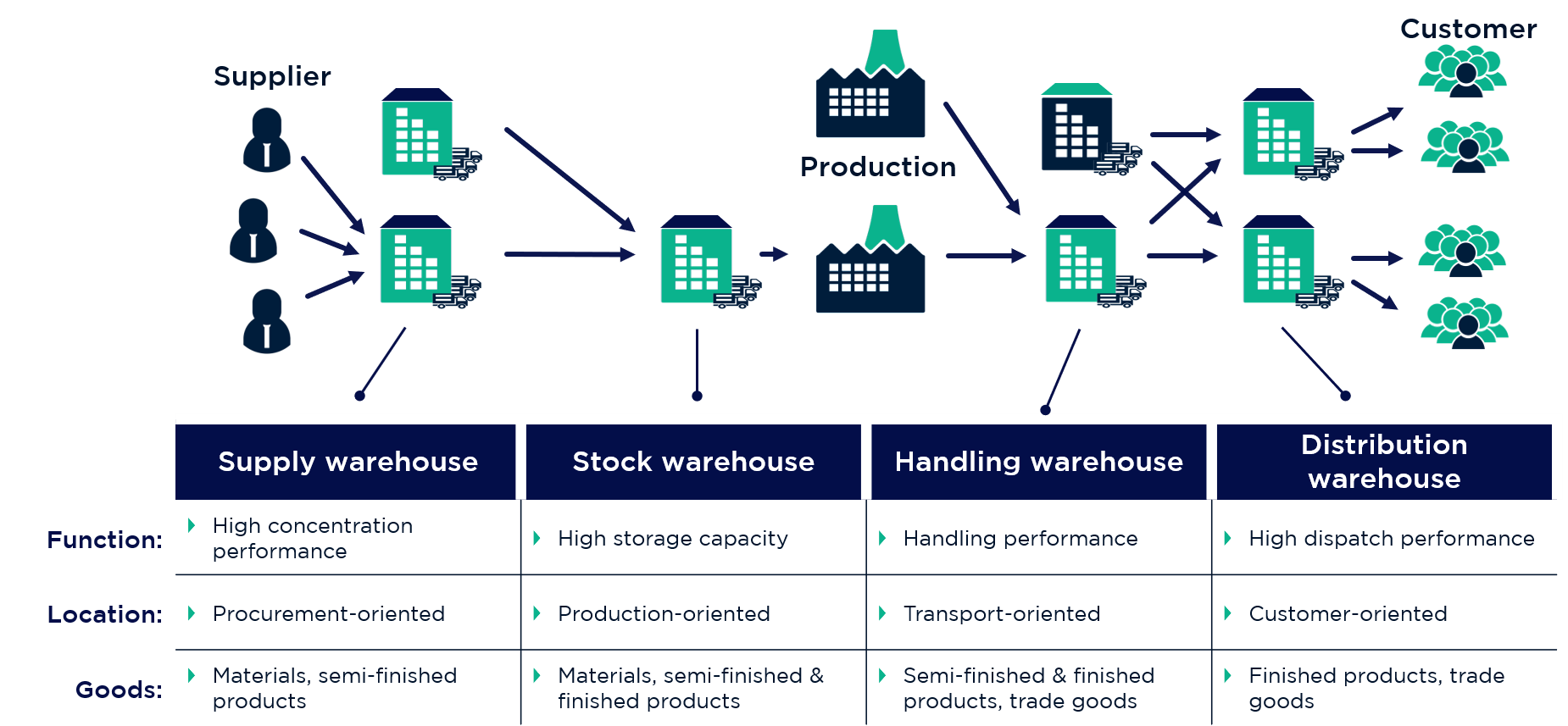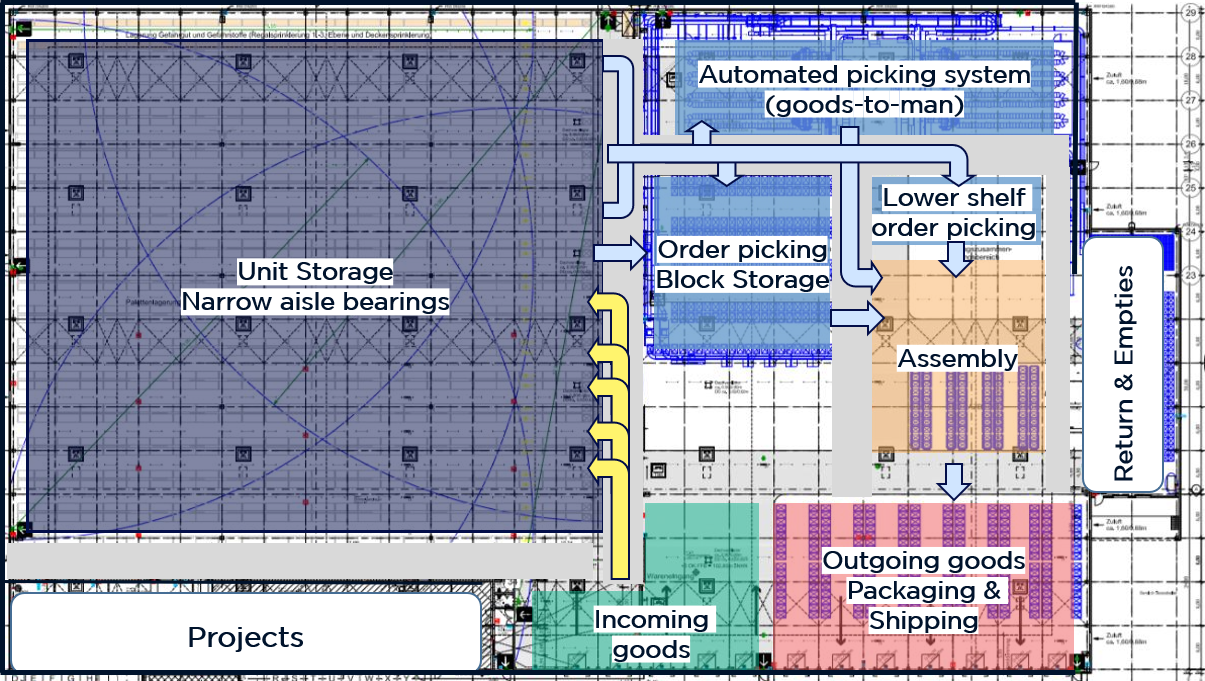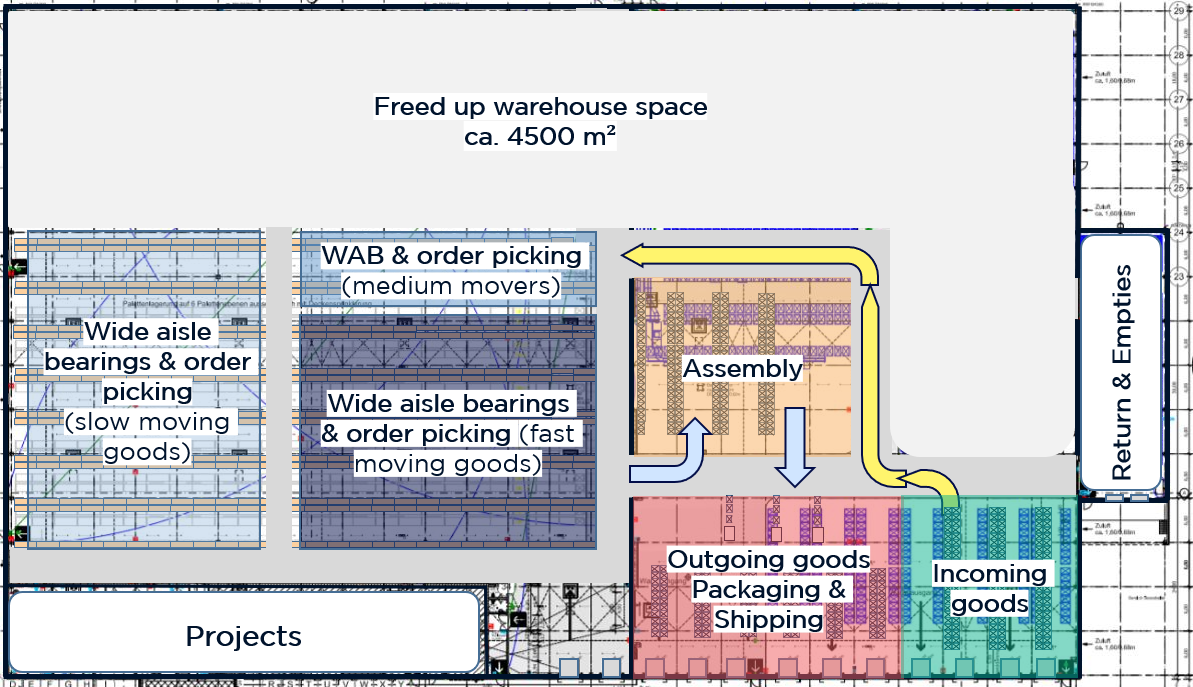- Supply Chain Strategy
- Supply Chain Network Design
- Inventory Management & EOQ
- Route Optimisation
- Distribution Logistics Tendering
- Fulfillment & Warehouse Logistics
- Last Mile Transport Tender
- eSCM & Supply Chain Analytics

Fulfillment and warehouse logistics - How effective warehouse management contributes to your company's success
Through warehouse optimization and the design of efficient warehouse logistics, raw materials, auxiliary materials, semi-finished products, and finished products are kept in stock at optimal cost, then picked, shipped, and quickly supplied to the supply chain when needed. The increase in just-in-time strategies, a growing number of variants, shorter delivery times, and a greater focus on working capital are all causing an increase in the number and range of tasks that need to be mastered as well as enhancing the cost pressure on warehouse logistics and fulfillment. Warehouse management as a competitive factor has long since arrived in the battle of the supply chains. In this context, questions arise such as:
- Why is the value contribution of warehouse optimization so often underestimated?
- Is the warehouse suitable in terms of alignment, structure, and dimensioning?
- How can optimization of warehouse logistics and storage space allocation reduce warehouse costs and increase warehouse performance?
- What influence do picking techniques, packaging systems, and loading planning have?
- What contribution does digitalisation through a warehouse management system make?
In the following sections, we highlight the most relevant questions, discuss challenges and approaches to solutions, and provide an outlook on how supply chain decision-makers can use warehouse optimization to make a decisive contribution to the company's success.
The value contribution of fulfillment and warehouse optimization can be enormous - why?
Warehouse managers and supply chain decision-makers are usually aware of the role a well-positioned warehouse can fulfill in a supply chain and the added-value it can bring to a company. However, in order to make this contribution continuously, the regular – and above all strategic – development and adjustment of the warehouse is necessary.
The goal of warehouse optimization is to reduce warehouse costs, warehouse logistics effort, and working capital while maximising warehouse performance. The differences in terms of warehousing costs, working capital, and performance of an optimised warehouse compared to a warehouse that has existed for a long time and has not been considered strategically can be immense. The total annual cost of a warehouse due to rent, depreciation, and personnel is often one of the largest unnoticed cost categories in a company. A common reason for this is a lack of review – opportunities are not recognised or changes are considered too complex from the outset.
In addition, fulfillment or warehouse optimization initiatives often fail to materialise because warehouse managers simply do not have the bandwidth alongside their operational duties. For example, the strategic review of the influence of the warehouse structure on working capital or personnel costs due to inefficient material flow are time-consuming and analytically demanding, requiring knowledge of the latest developments on the market.
In order to incorporate new developments and perspectives into your considerations and to counteract the risk of a historically established "operational blindness", you should check whether your existing warehouses can be optimised in the following four ways.
Is the warehouse suitable in terms of alignment, structure and dimensioning?
Warehouse costs are significantly influenced by the warehouse location, structure, and dimensioning. Since a change to any of these is usually capital-intensive and has to deal with many dependencies (for example, between the warehouse location and where the personnel live) warehouse managers often shy away from seeking out optimization opportunities in this regard.
Warehouse capacities can only be optimally utilised in terms of working capital if the warehouse is correctly dimensioned and structured. Many companies also keep too much inventory due to overly large warehouse capacities, therefore suffering excessive working capital. On the contrary, if the warehouse is too small, the material flow and warehouse logistics can be disrupted through overloading and thus perform inefficiently.
The warehouse dimensions must match the required storage capacity and the storage areas must be structured accordingly. In view of the fact that a warehouse is often intended to last for several years, and that stored goods can change in type, quantity, and number, forecasts of future warehouse capacities are highly important. This also means that such forecasts should be repeated on a regular basis in order to best capture the inflection point at which a move or conversion is more worthwhile than continuing to operate an inefficient warehouse. This safeguards the future!
Another pitfall is improper warehouse design. A warehouse must be aligned in terms of purpose, functionality, location, the specific requirements for the stored goods, and its role within the supply chain. If the product range, suppliers, sales markets, or the supply chain change, under the new circumstances, the once appropriate alignment can become costly and inefficient.

Therefore, supply chain managers should make the following assessments as part of a fulfillment or warehouse optimisation initiative:
- Change: Have the circumstances (warehouse purpose, function, location, type and assortment of goods) changed compared to the original plan for the warehouse and what are the requirements for the warehouse in the medium to long term based on current forecasts. This can be evaluated by means of workshops on strategic warehouse orientation as well as a location analysis
- Warehouse capacities: Assuming optimal inventory levels per item as well as optimal order quantities, how high is the theoretical utilisation of warehouse capacity compared to actual utilisation. For this purpose, an analysis of the warehouse and material flow capacities in comparison with the actual warehouse movements is suitable
- Structure of the warehouse: Are the arrangement and dimensioning of the individual warehouse areas optimal? In a warehouse area analysis, the capacity, performance, and associated personnel of each warehouse area can be checked and compared with the functional requirements of the warehouse
- Alternative warehouse equipment: The productivity of a warehouse is largely determined by its equipment. New technology and various other options create opportunities to increase warehouse productivity within existing structures. An investment evaluation of alternative racking systems, load containers, conveyors etc. provides information on the potential for optimization

In order to make a decision regarding the location, structure and dimensions of a warehouse, transparent data should be used to make a calculation comparing the overall and per item warehousing costs against the investment costs. If a warehouse is far from the optimum then optimization is worth considering, including: restructuring, reconstructing or relocating an existing warehouse, or relocating certain items to other sites.
In our article about warehouse planning, you can find out how to proceed with "greenfield" warehouse planning and what needs to be considered in the context of warehouse conversion.
How can optimization of warehouse logistics and storage location allocation reduce fulfillment and warehouse costs and improve logistics performance?
Warehouse logistics is comprised of the organisation, control, and execution of the material flow within a warehouse. The material flow describes the route taken by a good from goods receipt to goods issue. Transport costs are incurred with each route and with each merger and separation of items in the material flow, for example during order picking, new material bundles are created that are henceforth moved separately or together. Since, in most cases, when retrieving goods, the number of orders for items increases, but the number of units decreases, this material flow results in higher transport costs and greater time pressure than the storage process.
The transport costs caused by the material flow are influenced not only by the warehouse structure and the available means of conveyance, but also to a large extent by the storage location allocation or layout of the warehouse. In particular, changes in the range of items, the demand quantities of individual items, or new patterns of order interrelation between the items can change the optimal storage space allocation. The selected storage philosophy is also decisive in determining whether the material flow can take place quickly and at optimal cost (e.g. transport routes vs. working capital).

Frequent effects of inefficient material flows are overlong and therefore cost-intensive transport routes and slow throughput times. From experience, many companies react to such situations by deploying additional personnel instead of fixing the material flow. Especially in rack warehouses or warehouses with too few transport areas, a disorderly material flow can lead to vehicles getting in each other’s way.
In an example of a warehouse optimization project, warehousing costs could be reduced immensely. The warehouse was oversized and ineffective in its alignment and use. Warehouse resource expenditure was significantly reduced through transport route savings and improved picking performance (through storage location allocation and the relocation of the picking process to the wide aisle warehouse). In addition, the space costs of the 12,000sqm retail warehouse were reduced by 4,500sqm, which could be used for different purposes or rented out. Working capital was lowered to an optimum by reducing inventory levels.

In order to evaluate the current status of warehouse logistics and the material flow, material flow analysis in the context of warehouse optimisation should be carried out. This helps to evaluate the arrangement of the warehouse areas (warehouse layout) as well as the transport routes and conveyors. The analysis with regard to throughput times and transport costs and a corresponding depiction of the individual process steps along the material flow can help to identify problem areas and evaluate opportunities for improvement. These may include alternative material flow concepts, different storage layouts, a different philosophy of storage location allocation, or a technical modification of the conveyor systems and means.
What is the influence of picking techniques, packaging systems, and loading planning?
Due to smaller bundle sizes and higher order numbers, picking, packing and loading are among the most resource-intensive areas of a warehouse and should therefore be closely considered in a warehouse optimization initiative.
With respect to order picking, the first question that arises is whether it makes sense to set up a separate picking area within the warehouse. At the cost of an additional transfer between unit storage and the picking area, as well as the additional space required, a separate picking area shortens transport routes and facilitates the picking processes. In addition, the use of the appropriate picking technology should be examined. Depending on the type of goods and turnover as well as the cost for investment and resources, a distinction should be made between goods-to-man and man-to-goods picking technology as well as between multi-order picking vs. single-order picking. It needs to be determined whether man-to-goods techniques or their further development such as pick-by-light, pick-by-voice, or pick-by-sight are the most suitable for the application, or whether goods-to-man techniques with fully automatically controlled pallet or tote rack servicing devices are more suitable for bringing the goods to the picker. These considerations are especially importat within fulfillment centers as these usually face very small order sizes.
In the context of packing, the packaging system should be checked with regard to efficient micro processes and a functional check of the packaging. Sequence process analyses are well suited for identifying the potential for optimization and for finding practical solutions. It is often in the small, manual, and therefore resource-intensive processes that the greatest opportunities, relatively speaking, can be found and easily implemented.
Within the framework of loading planning, shipping planning should be examined with regard to even capacity utilisation. Load peaks, associated waiting times, and staging storing lead to the requirement of additional storage space and the uneven productivity of shipping resources. Via agreements or with the help of digital slot-booking applications, fixed shipping slots can be allocated and optimization potential can be realised. Another lever in loading capacity is shipping capacity utilisation. Particularly in industries with high customer power or competition in delivery lead times, un-utilised shipping capacity can often be observed. Possible solutions range from capacity-oriented order discounts to incentivise the customer to use some of the spare capacity, to the use of freight exchanges to utilise the remaining capacity elsewhere.
What contribution can digitalisation through a warehouse management system make?
Warehouse management systems have progressed warehouse logistics and warehouse optimisation in recent years. They record all movements of intra-warehouse logistics and thus map all warehouse processes along the material flow through all the stations from goods receipt to goods issue. The information of each process step can be reported to the Warehouse Management System.
Central advantages of a warehouse management system are:
- Support for working capital optimisation of inventories and order quantities
- Process automation, especially in data acquisition, calculation of performance KPIs, or integration of automated conveyors or robotics
- Support in optimizing the warehouse layout by grouping and sorting items in the context of storage location allocation
- Real-time data and connection to the company-wide data sets (e.g. ERP system) allow for the inclusion of forecasts in decision-making processes by means of current real-time values
- Support in staffing and workforce decisions from driving the workforce´s efficiency to managing the right level of resources
In the context of fulfillment and warehouse optimization, inventory systems must be examined to determine the extent to which they provide the relevant benefits. Often, the full potential of implemented systems is not used because it is insufficiently integrated into operational and decision-making processes or is not supported with the sufficient data quality and coverage. In many cases, existing systems are also outdated and a selection of a new system is worthwhile.
The requirements and integration of a software-controlled warehouse into the supply chain are always unique and the supplier market for software solutions – boasting more than 90 solutions – can be overwhelming. Consequently, the selection, implementation, and further development of warehouse management systems often turn into mammoth projects. Unfortunately, too often, these initiatives do not produce the desired results due to a lack of experience, a lack of proper integration, and the failure to address the strategically important issues.
Fulfillment and warehouse optimization conclusion and outlook
The added competitiveness of a capacity-optimised warehouse with low storage costs and working capital, as well as efficient fulfillment and warehouse logistics and high handling performance, can be immense - especially if warehousing is a large cost component for the company. The increased demands on logistics and the complex, multi-causal interrelationships of material flow, structure, processes, technology, and digital capabilities make warehouse optimization a real but very rewarding challenge for your supply chain department.
Supply chain decision makers and warehouse managers can help ensure that the warehouse and supply chain is in the best possible position today and in the future by ensuring maximum efficiency and performance now.
OCM helps you with warehouse optimization, warehouse management, the optimization of all related warehouse logistics processes, and the corresponding digitalisation projects in order to sustainably reduce warehouse costs and working capital.
We would be happy to present our expertise and consulting modules in this regard or discuss concrete solutions based on your challenges.

Our project modules at a glance:
Logistics optimisation & Supply Chain Consulting modules
Logistics & SCM Opportunity Assessment
- Benchmarking & maturity testing
- Identification of opportunities & action plan
Transport Partner Management
- Transport partner strategy & professionalisation
- Securing resources and resource training design
Transport Tender
- Competition, effective transport tendering, fact-based negotiation
- Transport cost reduction
Freight & Logistics Tender
- Competitive pricing, quality, and performance assurance
- Individual weight-distance matrix
Warehouse Optimisation
- Efficient warehouse logistics & layout
- Optimised processes & working capital
Logistics Cooperation
- Optimising logistics through synergies
- Finding a fair and stable collaboration model
Route Optimisation
- Distance and route reduction
- Reduce resource & logistics costs
Supply Chain Network Optimisation
- Optimise delivery times, service levels, & processes
- Reduce working capital
Inventory & Order Management
- Optimal order quantity & stock on hand
- Optimise working capital
Fleet Optimisation
- Fleet concept tailored to requirements
- Cost optimisation
Supply Chain & Logistics Strategy
- Sustainable maximum value contribution of the supply chain
- Clear objectives, concrete measures
Digital Logistics Management & Reporting
- Information advantages in speed, scope, & significance
- Efficiency through automation, data integration & process simplification
Interim Supply Chain & Logistics Manager
- Rapid response: candidates within 48h
- Matching of requirements and assessment of suitability using logistics experts
- From dispatcher to logistics manager
Short-term staff shortage? Unexpected need for action?
Learn more